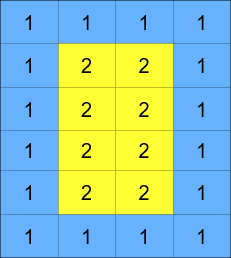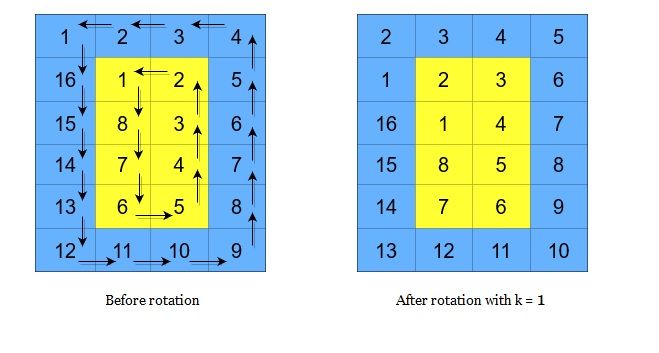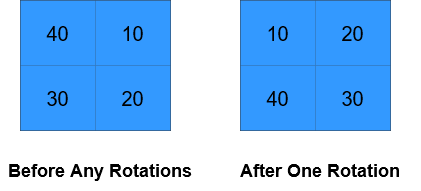You are given an m x n integer matrix grid, where m and n are both even integers, and an integer k.
The matrix is composed of several layers, which is shown in the below image, where each color is its own layer:
A cyclic rotation of the matrix is done by cyclically rotating each layer in the matrix. To cyclically rotate a layer once, each element in the layer will take the place of the adjacent element in the counter-clockwise direction. An example rotation is shown below:
Return the matrix after applying k cyclic rotations to it.
Example 1:
Input: grid = [[40,10],[30,20]], k = 1 Output: [[10,20],[40,30]] Explanation: The figures above represent the grid at every state.
Example 2:
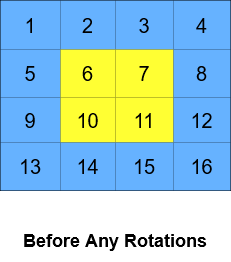
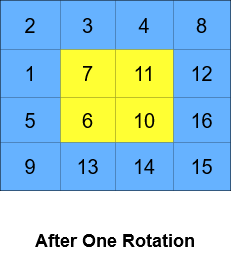
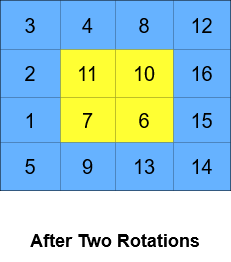
Input: grid = [[1,2,3,4],[5,6,7,8],[9,10,11,12],[13,14,15,16]], k = 2 Output: [[3,4,8,12],[2,11,10,16],[1,7,6,15],[5,9,13,14]] Explanation: The figures above represent the grid at every state.
Constraints:
m == grid.lengthn == grid[i].length2 <= m, n <= 50- Both
mandnare even integers. 1 <= grid[i][j] <= 50001 <= k <= 109
class Solution:
def rotateGrid(self, grid: List[List[int]], k: int) -> List[List[int]]:
def rotate(grid, s1, e1, s2, e2, k):
t = []
for j in range(e2, e1, -1):
t.append(grid[s1][j])
for i in range(s1, s2):
t.append(grid[i][e1])
for j in range(e1, e2):
t.append(grid[s2][j])
for i in range(s2, s1, -1):
t.append(grid[i][e2])
k %= len(t)
t = t[-k:] +t[:-k]
k = 0
for j in range(e2, e1, -1):
grid[s1][j] = t[k]
k += 1
for i in range(s1, s2):
grid[i][e1] = t[k]
k += 1
for j in range(e1, e2):
grid[s2][j] = t[k]
k += 1
for i in range(s2, s1, -1):
grid[i][e2] = t[k]
k += 1
m, n = len(grid), len(grid[0])
s1 = e1 = 0
s2, e2 = m - 1, n - 1
while s1 <= s2 and e1 <= e2:
rotate(grid, s1, e1, s2, e2, k)
s1 += 1
e1 += 1
s2 -= 1
e2 -= 1
return gridclass Solution {
public int[][] rotateGrid(int[][] grid, int k) {
int m = grid.length, n = grid[0].length;
int s1 = 0, e1 = 0;
int s2 = m - 1, e2 = n - 1;
while (s1 <= s2 && e1 <= e2) {
rotate(grid, s1++, e1++, s2--, e2--, k);
}
return grid;
}
private void rotate(int[][] grid, int s1, int e1, int s2, int e2, int k) {
List<Integer> t = new ArrayList<>();
for (int j = e2; j > e1; --j) {
t.add(grid[s1][j]);
}
for (int i = s1; i < s2; ++i) {
t.add(grid[i][e1]);
}
for (int j = e1; j < e2; ++j) {
t.add(grid[s2][j]);
}
for (int i = s2; i > s1; --i) {
t.add(grid[i][e2]);
}
int n = t.size();
k %= n;
if (k == 0) {
return;
}
k = n - k;
for (int j = e2; j > e1; --j) {
grid[s1][j] = t.get(k);
k = (k + 1) % n;
}
for (int i = s1; i < s2; ++i) {
grid[i][e1] = t.get(k);
k = (k + 1) % n;
}
for (int j = e1; j < e2; ++j) {
grid[s2][j] = t.get(k);
k = (k + 1) % n;
}
for (int i = s2; i > s1; --i) {
grid[i][e2] = t.get(k);
k = (k + 1) % n;
}
}
}
